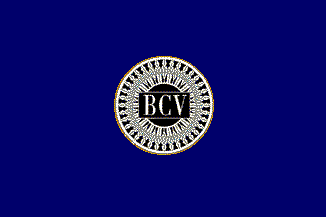
by Guillermo T. Aveledo, 21 December 1999

Last modified: 2004-12-22 by dov gutterman
Keywords: venezuela | bank | comptroller | police | petroleum |
Links: FOTW homepage |
search |
disclaimer and copyright |
write us |
mirrors
See also:

by Guillermo T. Aveledo, 21 December 1999
Banco Central de Venezuela (Central Bank of Venezuela) :
Description: A Dark Blue field, with the Seal of the Banco
Central de Venezuela (BCV) centered on it. This seal mimicks a
coin, and it is usually black with embroiderments of white,
encircled in ocre. There is also a coloured version of the Seal,
also used on flags (haven't found it yet).
Guillermo T. Aveledo, 21 December 1999
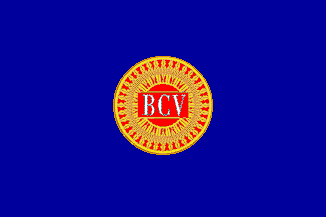
by Guillermo T. Aveledo, 1 March 2000
This is a variant of the flag of Venezuela's Central Bank.
This one, instead of a black and white seal has an ocre and red
seal. Both variants are usually hoisted alternatively with no
protocol which would specify their different meanings (if any).
Word is up that a slight change in the flag's logo is coming...
Guillermo T. Aveledo, 1 March 2000
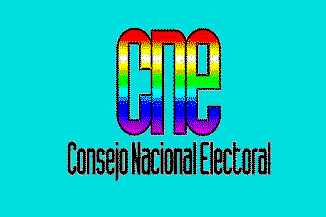
by Guillermo T. Aveledo, 1 June 2000
The flag of the Consejo Nacional Electoral, head of the
Electoral Power in Venezuela. Logo designed in 1997 by Santiago
Pol. The flag is decorative, for standing pole rather than to be
flown. The Consejo Nacional Electoral, the main electoral
authority in Venezuela.
Guillermo T. Aveledo, 1 June 2000
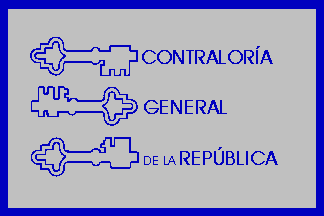
by Guillermo T. Aveledo, 1 March 2000
General Comptroller Office flag:
A grey field framed by a thin blue band (this is not a fringe;
it's part of the flag), and inside it the semblem of the General
Comptroller's Office: the THREE KEYS, and the words
"Contralori'a General de la Repu'blica" (CGR), in blue.
This Comptroller's Office wwas created as the "Contralor?a
Nacional" in 1938, receiving its current name with the
framing of the 1961 constitution, which has remained after the
drafting of the New Constitution of 1999. This flag flies outside
the building of the CGR, its pole being diagonally attached to
the building itself, whereas a national flag is hoisted on its
own sanding polea few meters in front of the building (a must
according to the Venezuelan Flag Law).
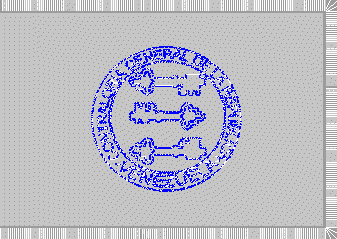
by Guillermo T. Aveledo, 1 March 2000
General Comptroller flag:
This flag, all grey, has a lighter grey fringe (being usually a
desktop, or an office flag, not a flag to be hoisted ouiside),
made out of shiny taffeta, and iwth the CGR's seal embroidered on
its center. The seal consists of two concentric circles of blue,
and the words "Contralori'a General de la Repu'blica -
Venezuela" arranged in circular fashion inside the outer
circle. Inside the inner circle, we can see the CGR's Three Keys.
The Symbol of the Three Keys :
The first book of the Real Hacienda of the Venezuelan Provoince
dates from the 29th of April of 1529, and it starts with an
"account of the money collected by Juan de Amp?es and its
people while Governor Micer Ambrosio landed on this land".
Two months after the arrival on the first Belzares expedition,
captained by Governor Ambrosio Alfinger, in Coro (the the capital
of the province of Venezuela, the first registers of the Real
Hacienda take place, under the supervision of a
"Treasurer", an "Accountant" , a "Writer
and Observer". The functions of these three Royal Officials
was ruled by a 'Cedula Instruccio'n' issued by the Queen Jane of
Spain (Juana la Loca) the 17th of February of 1531. The Cedula
said especifically that the three Royal Officers had a duty
to deposit on a Coffin "all the gold a pearls belonging to
the King". The Coffin had three keys with three diferent
locks, each of the Royal Officials being issued with one of the
keys. It was warned that no one could substract "no gold, no
pearl, no coin" from the Coffin without the agreement and
presence of the three Royal Officers, as a way to avoid fraud and
mishandling of funds. The three Royal Officers also kept each a
separate book reccording the accounts of the coffin, whose
contents wer transcribed later to a General and Common Book of
Control. And nothing could be taken away od deposited in the
Royal Coffin without being entered in such a book, and this under
the presence of the Governor.
The Real Cedula of the 17th of February of 1531 serves as a
revealing document of the care and vigilance which Spain exerted
over the control and handling of her administration and of her
ultramarine posessions. It is, in fact, a historical precedent,
obvious differences aside, if what is and represents the General
Comptroller's Office. Hence, the symbol of the Three Keys.
Manuel Trujillo. Archivo Histo'rico de la CGR (adapted
and translated by Guillermo Aveledo)
Jaume Olle' asked:
Can you check if the writing in the flag of the Controladuria
General de la Republica is correct. The word
"contraloria" seems a bit strange.
And Santiago Dotor replied:
As far as I know "Contraloria" is perfectly correct in
South America. There is no fully equivalent term in Spain, and we
would call this "Tribunal de Cuentas" and/or
"Intervenci?n General del Estado". And I guess the
leading officials in that organisation are
"contralores" which in Spain would be
"interventores".
The term is indeed "contraloria". But yes, it sounds
funny and its very difficult to translate properly; now the
situation has worsened because the status of the Contraloria
[which I had named Comptroller's office] has been altered under
the new Venezuelan Constitution of 1999. No changes on the flag,
though (but a very slight modification of the dimensions might be
ordered). The term might be that strange, since it is originally
a French word. I checked the DRAE (Diccionario de la Ral Academia
Espan~ola), and it said as fo